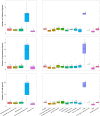Distribution patterns and drivers of urban green space and plant diversity in Haikou, China
- PMID: 37670868
- PMCID: PMC10476625
- DOI: 10.3389/fpls.2023.1202115
Distribution patterns and drivers of urban green space and plant diversity in Haikou, China
Abstract
Investigating historical and ongoing changes in urban green space (UGS) and urban plant diversity (UPD) provides critical insights into urban ecology and urban planning development. The present study illuminates some of the transformations which can occur in rapidly developing urban landscapes. In this work, we used 30 m resolution images from the Landsat 5 satellite from 2015 to investigate UGS patterns in Haikou City, China. Metrics of UPD were obtained using field surveys, allowing the proportion of UGS and UPD to be determined in each urban functional unit (UFU) of Haikou. The results revealed that leisure and entertainment areas (such as parks) had the highest diversity, whereas roads and transportation hubs had the lowest. More frequent anthropogenic maintenance had a positive effect on the total number of species, including cultivated, tree, and herb species. Similarly, increased watering frequency had a positive impact on the diversity of cultivated and shrub species. By providing demonstrating a crucial link between UGS and UPD, the results provide valuable information for planning sustainable urban development in Haikou City and other tropical regions. They highlight the important role of UGS in maintaining biodiversity and providing a range of ecosystem services. This research will inform policymakers and urban planners about the need to consider UGS and UPD in urban planning and management process, in order to promote sustainability and conservation of biodiversity.
Keywords: conservation; maintenance times; urban functional unit (UFU); urban plant diversity (UPD); watering frequency.
Copyright © 2023 Zhang, Guo, Nizamani and Wang.
Conflict of interest statement
The authors declare that the research was conducted in the absence of any commercial or financial relationships that could be construed as a potential conflict of interest.
Figures







Similar articles
-
Spatiotemporal Variation of Urban Plant Diversity and above Ground Biomass in Haikou, China.Biology (Basel). 2022 Dec 14;11(12):1824. doi: 10.3390/biology11121824. Biology (Basel). 2022. PMID: 36552334 Free PMC article.
-
Perceptions of ecosystem services, disservices and willingness-to-pay for urban green space conservation.J Environ Manage. 2020 Apr 15;260:110140. doi: 10.1016/j.jenvman.2020.110140. Epub 2020 Jan 21. J Environ Manage. 2020. PMID: 32090834
-
Changes in urban green space configuration and connectivity using spatial graph-based metrics in Ardabil developing city, Iran.Environ Monit Assess. 2024 Aug 3;196(9):778. doi: 10.1007/s10661-024-12922-6. Environ Monit Assess. 2024. PMID: 39096409
-
[Research progress on urban green space].Ying Yong Sheng Tai Xue Bao. 2007 Jul;18(7):1640-6. Ying Yong Sheng Tai Xue Bao. 2007. PMID: 17886663 Review. Chinese.
-
[Research advance in ecosystem service of urban green space].Ying Yong Sheng Tai Xue Bao. 2004 Mar;15(3):527-31. Ying Yong Sheng Tai Xue Bao. 2004. PMID: 15228010 Review. Chinese.
References
-
- Alvey A. A. (2006). Promoting and preserving biodiversity in the urban forest. Urban. Forest. Urban. Greening. 5 (4), 195–201. doi: 10.1016/j.ufug.2006.09.003 - DOI
-
- Anguluri R., Narayanan P. (2017). Role of green space in urban planning: outlook towards smart cities. Urban. Forest. Urban. Greening. 25, 58–65. doi: 10.1016/j.ufug.2017.04.007 - DOI
-
- Aronson M. F., Piana M. R., MacIvor J. S., Pregitzer C. C. (2017). Management of plant diversity in urban green spaces. Urban. Biodivers., 101–120. doi: 10.9774/gleaf.9781315402581_8 - DOI
-
- Barnett D. T., Stohlgren T. J. (2003). A nested-intensity design for surveying plant diversity. Biodivers. Conserv. 12, 255–278. doi: 10.1023/A:1021939010065 - DOI
LinkOut - more resources
Full Text Sources

